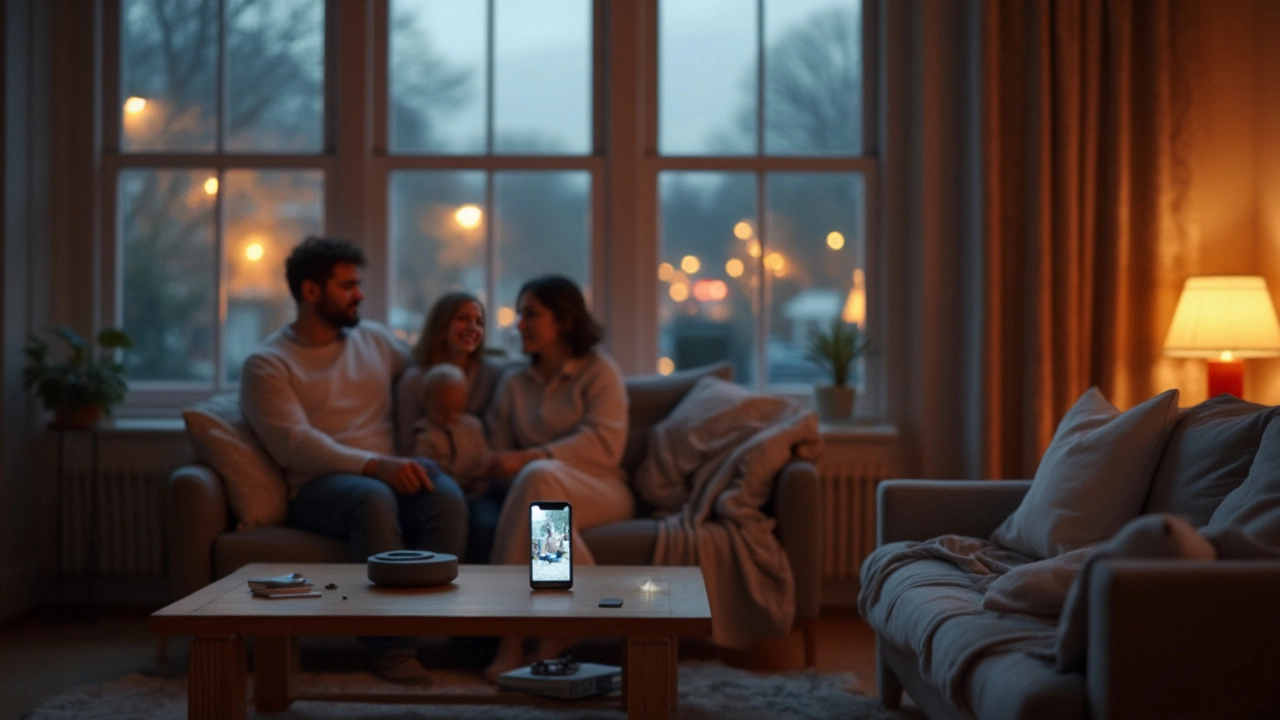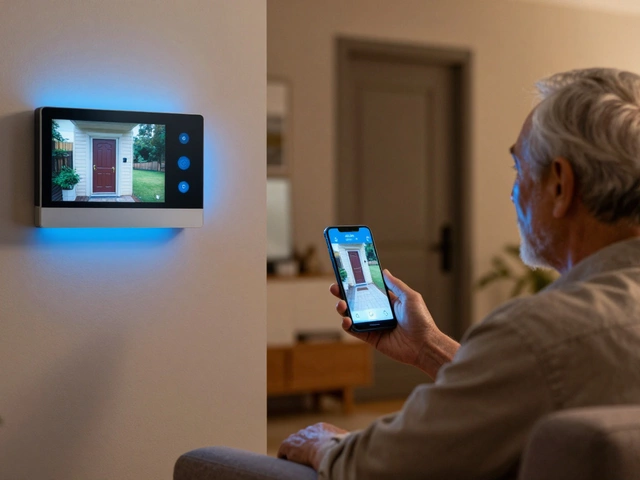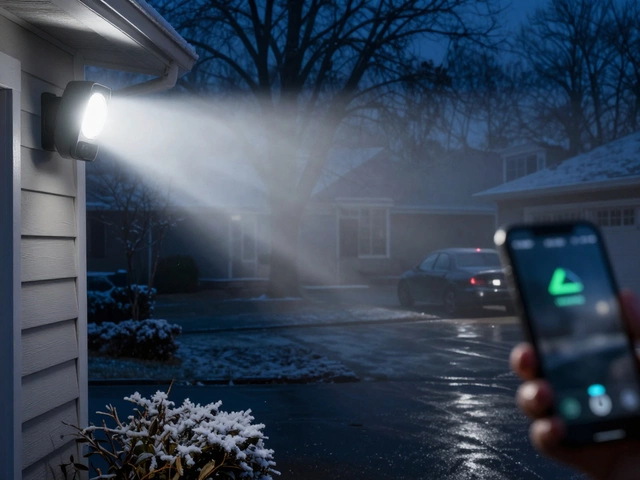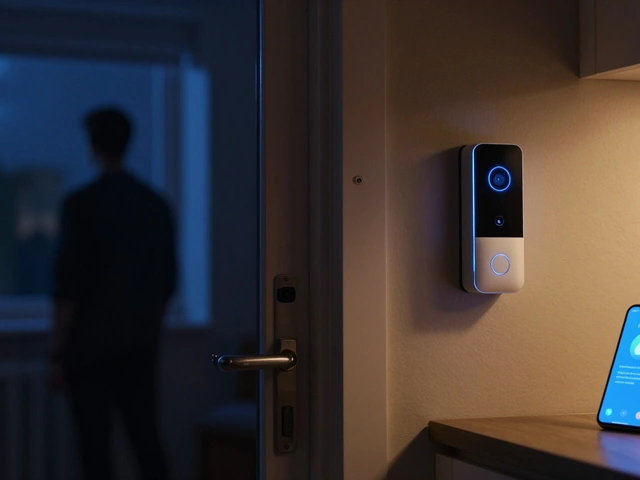If you’re looking at home security cameras and feeling overwhelmed, you’re not alone. All those numbers—megapixels, frames per second, infrared range—they look impressive, but what do they really mean for you and your front door?
To spot a camera that’s actually good, you want to focus on what improves safety, not just what sounds flashy. For starters, the clearest camera in the store won’t help if it turns into a blurry mess at night or sends you constant alerts every time a squirrel wanders past.
Here’s the trick: zero in on real-world stuff. Can you recognize a face in the footage? Does it switch easily to night vision and capture useable shots in total darkness? Are notifications quick and not constant false alarms? These questions cut through the noise and help you figure out if a camera is worth your hard-earned cash.
- Picture Quality: It’s All in the Details
- Night Vision: Can You See in the Dark?
- Smart Alerts and Motion Detection
- Storage Options: Where Does the Footage Go?
- Installation and Connectivity: Frustration-Free or Nightmare?
- Real-World Tips for Choosing Your Camera
Picture Quality: It’s All in the Details
When it comes to home security cameras, not all pixels are created equal. You’ll probably see cameras advertising 1080p, 2K, or even 4K resolution—those numbers matter. In simple terms, higher resolution means a clearer picture. With 1080p, you’ll usually recognize faces within 10-20 feet in daylight. If you’re covering a wide driveway or want to read a license plate, look at 2K or 4K models. These can capture sharper details and give you better evidence if something ever goes south.
But don’t just chase the biggest number. Look at the camera’s field of view. A wider view (like 120° or more) lets you monitor bigger spaces without blind spots. Some models offer a snug 90°, which works for hallways, but for outdoors or open areas, go wide or risk missing action just offscreen.
Don’t forget about frame rate. Videos in 30 frames per second look smooth and show action without skipping. If a package thief runs through your yard, choppy footage at 15fps can make them look like a blur. Stick with 25-30fps where possible.
You’ll also want to check how the camera performs with backlighting—this is called HDR (High Dynamic Range). With HDR, a camera won’t just show a black silhouette when someone stands in front of a bright window or sunset. That’s a game changer for front doors and driveways.
Here’s a handy table to help you compare what matters for picture quality:
| Feature | Good | Best |
|---|---|---|
| Resolution | 1080p | 2K/4K |
| Field of View | 90°–120° | 120°–160° |
| Frame Rate | 20fps | 30fps |
| HDR | No | Yes |
Bottom line: don’t get fooled by gimmicks. Solid, clear, wide footage (day and night) is what you want from any home security camera. The clearer your picture, the less likely you’ll end up with useless "guess who?" shots in an emergency.
Night Vision: Can You See in the Dark?
If you can’t see what’s happening at night, even the fanciest home security cameras are pretty much useless. Most break-ins actually happen after dark, so night vision isn’t some nice add-on—it’s essential. Modern security cameras use infrared LEDs to light things up for the camera, even though your naked eye won’t see that extra light.
Here’s the big thing to check: range. If a camera only sees 10 feet at night, that might miss a driveway or most of your yard. The sweet spot is at least 25-30 feet of clear infrared range, and some pricier models go up to 60 feet or more. A good camera keeps details sharp instead of turning things into fuzzy blobs.
Resolution and night vision go hand in hand. Some older cameras record in black and white after dark, but a handful now have low-light color night vision. This makes a massive difference if you need to ID the color of a jacket or car that shows up in your feed. Real-world surveillance tests done by Consumer Reports found that color in night mode improved recognition by more than 40% over regular black and white infrared.
"Night vision makes the difference between guessing and truly knowing what’s happening on your property after dark." — Consumer Reports, 2024 Security Camera Guide
If you want to compare, look for these specs in the product description:
- Infrared (IR) range, listed in feet or meters (the higher, the better for yards and alleys)
- Number of IR LEDs—more LEDs usually mean brighter, clearer night footage
- Look for terms like "color night vision" or "starlight sensor" for the latest tech
| Camera Type | Infrared Range (ft) | Color Night Vision |
|---|---|---|
| Arlo Ultra 2 | 25 | Yes |
| Ring Spotlight Cam | 30 | No |
| Wyze Cam v4 | 40 | Yes |
It’s always worth running a quick night test after you set up your camera. Walk around your yard, check the display, and make sure you can see faces and details clearly. That’s how you know your camera quality checks out—no guesswork, just real protection.
Smart Alerts and Motion Detection
Smart alerts and motion detection are the secret sauce for home security cameras. Nobody wants their phone to blow up every time a car drives by or a branch sways. Good cameras use smarter tech to recognize what actually matters—like packages arriving or someone sneaking by your garage.
Most modern home security cameras come with adjustable motion zones. This means you can pick what part of the camera’s view matters. Maybe you care about the walkway but not the neighbor's yard—just crop the zone, and the camera listens to you, not every leaf in the wind.
Some cameras take it up a notch with person, animal, and vehicle detection. A 2023 test by a major consumer tech group found that cameras with AI-powered detection cut down false alerts by over 70% compared to basic motion sensors. That’s less checking your phone over nothing. Google Nest and Arlo are two brands known for really nailing this feature.
Real-life tip: Set up your camera’s sensitivity so it’s not too twitchy. Most apps let you slide a bar or choose low/medium/high. Start with medium, then adjust so you’re not missing anything important—or losing your mind.
- Set up motion zones for only the important spots (like doors, driveways).
- Test the camera with real-life movement: walk in front, see if you get an alert.
- Use the option for people-only or package alerts if your camera supports it. These are super handy if you're getting deliveries often.
| Camera Brand | Motion Detection Types | Custom Zones | Person Recognition |
|---|---|---|---|
| Arlo Pro 5S | Standard, Animal, Vehicle, Person | Yes | Yes |
| Google Nest Cam | Person, Animal, Package | Yes | Yes |
| Wyze Cam v3 | Basic, Sound | Yes | No |
Every camera has its own strengths, but the goal is simple: alerts should be fast, accurate, and dead easy to control. That’s what makes motion detection actually useful, not just another annoying ping.
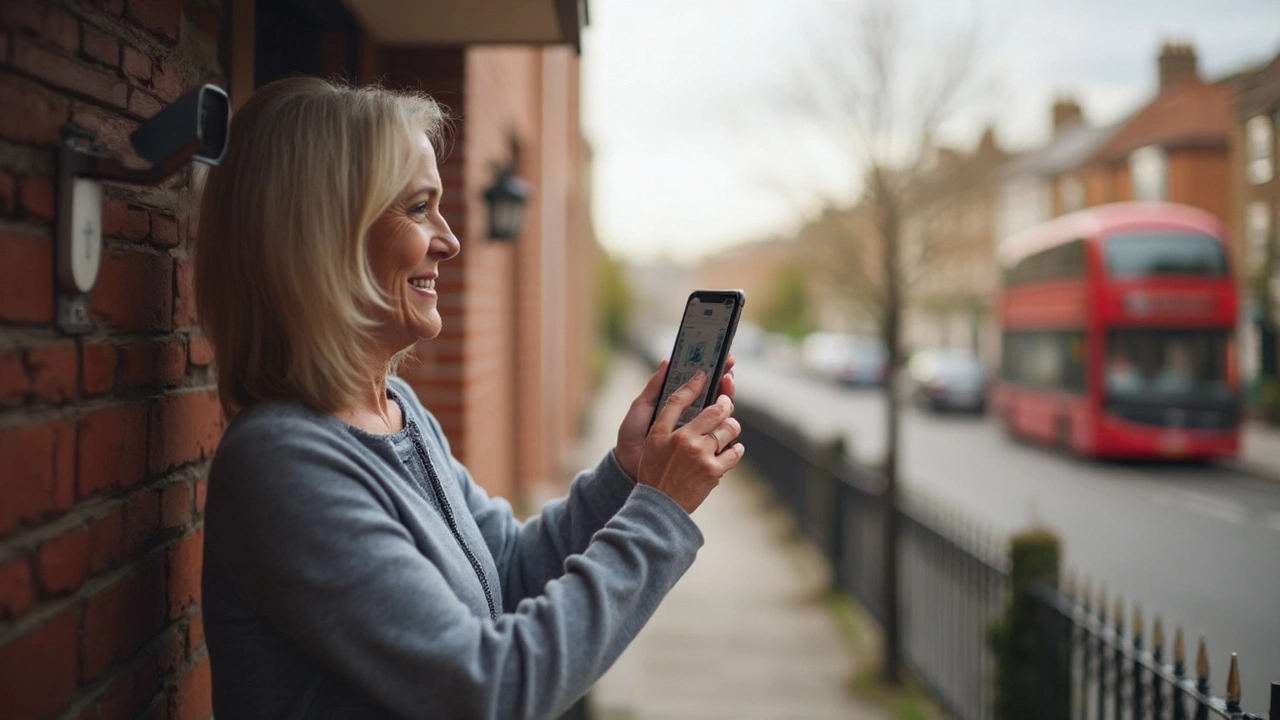
Storage Options: Where Does the Footage Go?
Here’s the bottom line: where your home security camera stores its footage matters just as much as what it captures. Not all cams handle this the same way. You’ve got two main choices—local storage or cloud storage. Each has its ups and downs, so let’s break it down.
Local storage means everything the camera records sits on a microSD card, USB drive, or sometimes even a built-in hard drive. If your Wi-Fi goes out or your internet is spotty, the camera keeps recording. Plus, you avoid ongoing costs. But if someone swipes the whole camera or the storage gets full, you could lose everything. Most microSD cards max out at 256GB, which usually covers several days of footage at 1080p, depending on the camera’s settings.
Cloud storage keeps your videos on remote servers. If a break-in happens and the thief smashes the camera, you’ve still got the footage. That’s a huge win. Most brands, like Arlo and Ring, offer rolling plans—think 7 to 30 days of saved video. The catch? You pay a monthly or yearly fee, and you need a solid internet connection. Some services let you view old clips or download them, but free plans almost always have restrictions. Here’s what you typically see:
| Brand | Free Storage | Paid Storage |
|---|---|---|
| Ring | Screenshots/Preview Only | 60 days |
| Arlo | None | Up to 30 days |
| Google Nest | 3 hours event storage | 30/60 days |
Of course, privacy is big here. Cloud storage makes some people nervous. Your private moments are sitting on someone else’s server—how much does that bother you? Make sure to read up on your brand’s privacy settings and security practices. Some cameras even let you store footage on your own network (like a NAS or FTP server) but that’s a bit more techy.
So, when you’re picking a camera, ask yourself: Do you want hands-off, automatic cloud backups with a subscription? Or will swapping out SD cards and keeping everything on-site give you peace of mind?
Installation and Connectivity: Frustration-Free or Nightmare?
This is where a lot of folks either end up high-fiving themselves or pulling their hair out. Some home security cameras are basically plug-and-play. Others make you watch endless YouTube tutorials or spend ages on hold with tech support. Here’s what separates the easy ones from the headache-inducers.
If you want less hassle, go for wireless cameras. Most models now connect through WiFi, which means you can stick them almost anywhere without running cables through walls. Just keep in mind: if your WiFi is spotty, the connection—and the footage—can get jerky or drop totally. Some top brands like Arlo and Eufy make setup a breeze with step-by-step phone instructions, while older or cheaper models often give you cryptic LED codes instead.
For power, you’ll pick between batteries, plugs, or even solar panels. Battery-powered units are flexible but need recharging every few weeks or months. Plug-in cameras are more reliable but mean you’re always tethered to an outlet. Solar options are getting better, but you need good sun exposure.
Now, here’s something most people overlook: the app. The camera can be perfect hardware-wise but if the app crashes or lags, you’ll never get those crucial alerts in real time. Look for ones that let you share access securely with family, allow for quick software updates, and don’t glitch every time your phone updates.
Let’s talk connectivity. Here’s a quick comparison table showing common options:
| Type | Pros | Cons |
|---|---|---|
| WiFi | No wires, flexible placement | Needs strong signal, can drop out |
| Ethernet | Stable connection, no WiFi needed | Cables everywhere, limits where you can mount |
| Cellular | Works off-grid or during outages | Needs data plan, higher cost |
Last tip: double-check if your camera works with your current smart home setup—Alexa, Google, or Apple HomeKit. Some home security cameras work flawlessly, others barely talk to your other gadgets. Save yourself frustration—read reviews about the setup process, test the app on your phone, and don’t get stuck with a camera that won’t play nice in your house.
Real-World Tips for Choosing Your Camera
Shopping for home security cameras gets a lot easier once you cut through clever marketing. Here’s what actually helps you find a winner—and avoid expensive regret.
- Prioritize camera placement. Think about where you actually need coverage. Front doors, driveways, and back entrances are usually the most at-risk spots. A lot of people stick a camera somewhere random and end up with hours of empty footage.
- Check the field of view. If a camera says it has a 110° or wider lens, that usually means fewer blind spots. Narrow lenses might miss important activity—like someone sneaking in from the side.
- Stick with 1080p resolution or higher. At lower resolutions, it’s tough to ID faces or license plates. Most reliable brands have gone full HD (1080p), but anything less is definitely outdated now.
- Night vision is a dealbreaker. Not all "night vision" is the same; some cameras see just a few feet in the dark, others push 25 feet or more. Look for ones that advertise at least 20 feet of infrared night vision. Bonus tip: Try to get a demo or sample footage.
- Test the app before you commit. The app is your main tool. This is where you see live feeds, get smart features like motion alerts, and check clips. If reviews mention laggy apps or missed notifications, skip it—there are better options.
- Know your storage needs. Cloud storage often means a monthly fee. Local storage (like microSD slots) can be cheaper but isn’t always as safe. Some cameras offer a few days of free cloud video, but always check the details before buying.
Take a look at this quick stat breakdown from 2024 showing what most buyers care about:
| Feature Buyers Prioritize | Percentage |
|---|---|
| Camera resolution (1080p+) | 81% |
| Night vision range | 69% |
| Motion alerts | 63% |
| Cloud storage options | 54% |
One last tip: always check how easy it is to get extra support or warranties from the brand. Cheap cameras with no customer service should instantly raise a red flag.
Stick to these points and you’ll save time, and money, and have way more peace of mind with your home security cameras.

